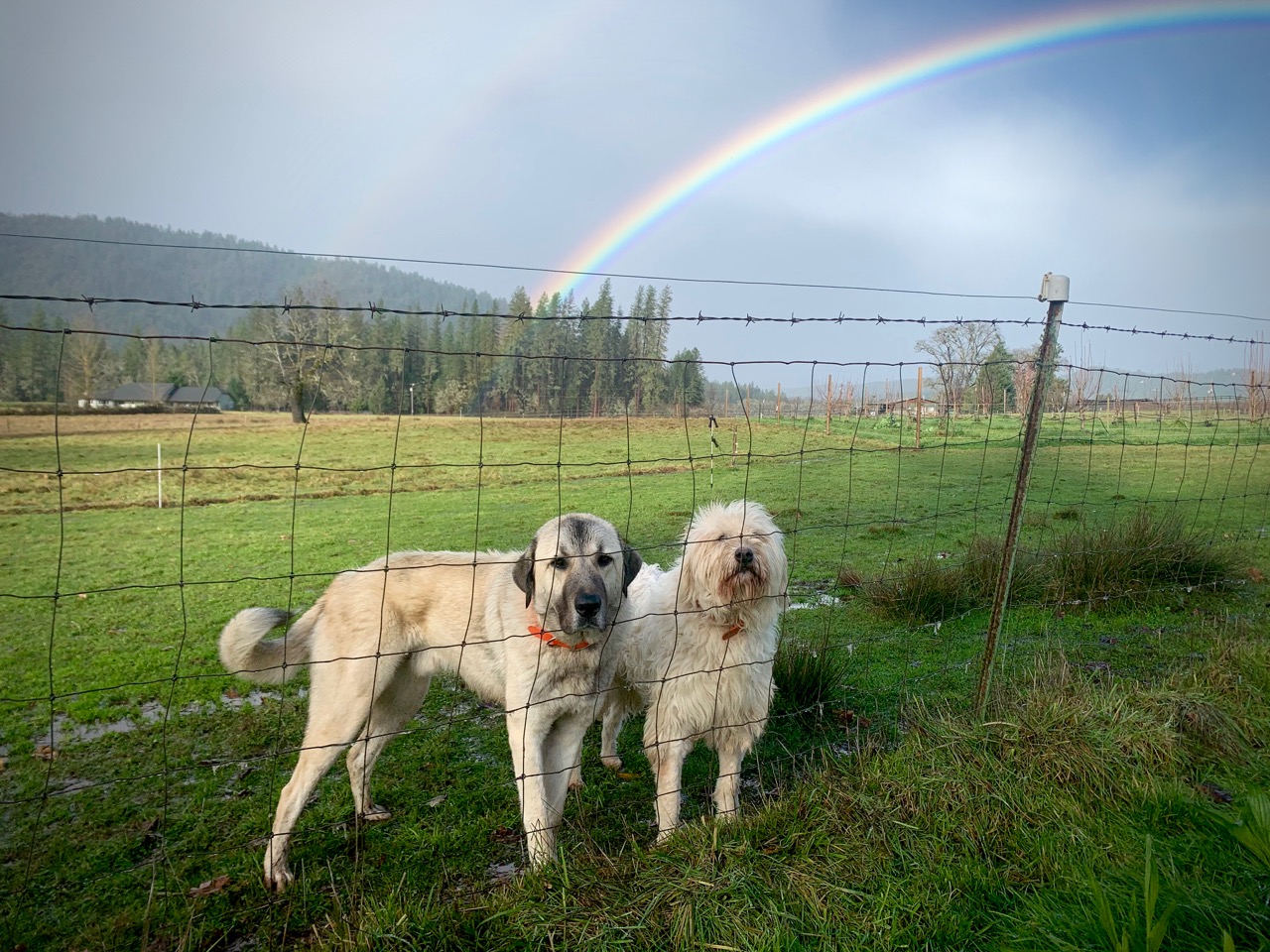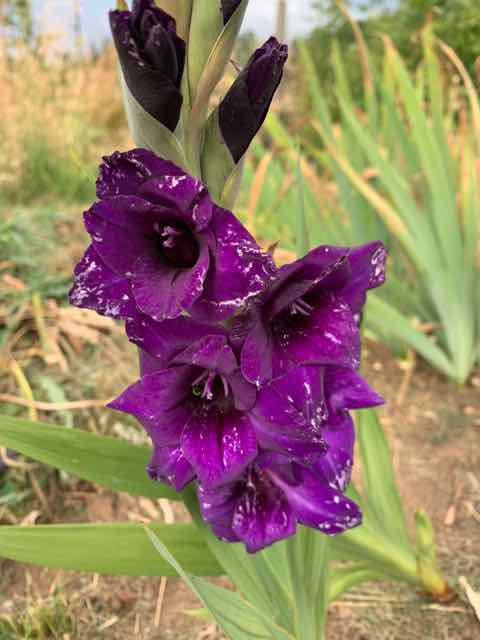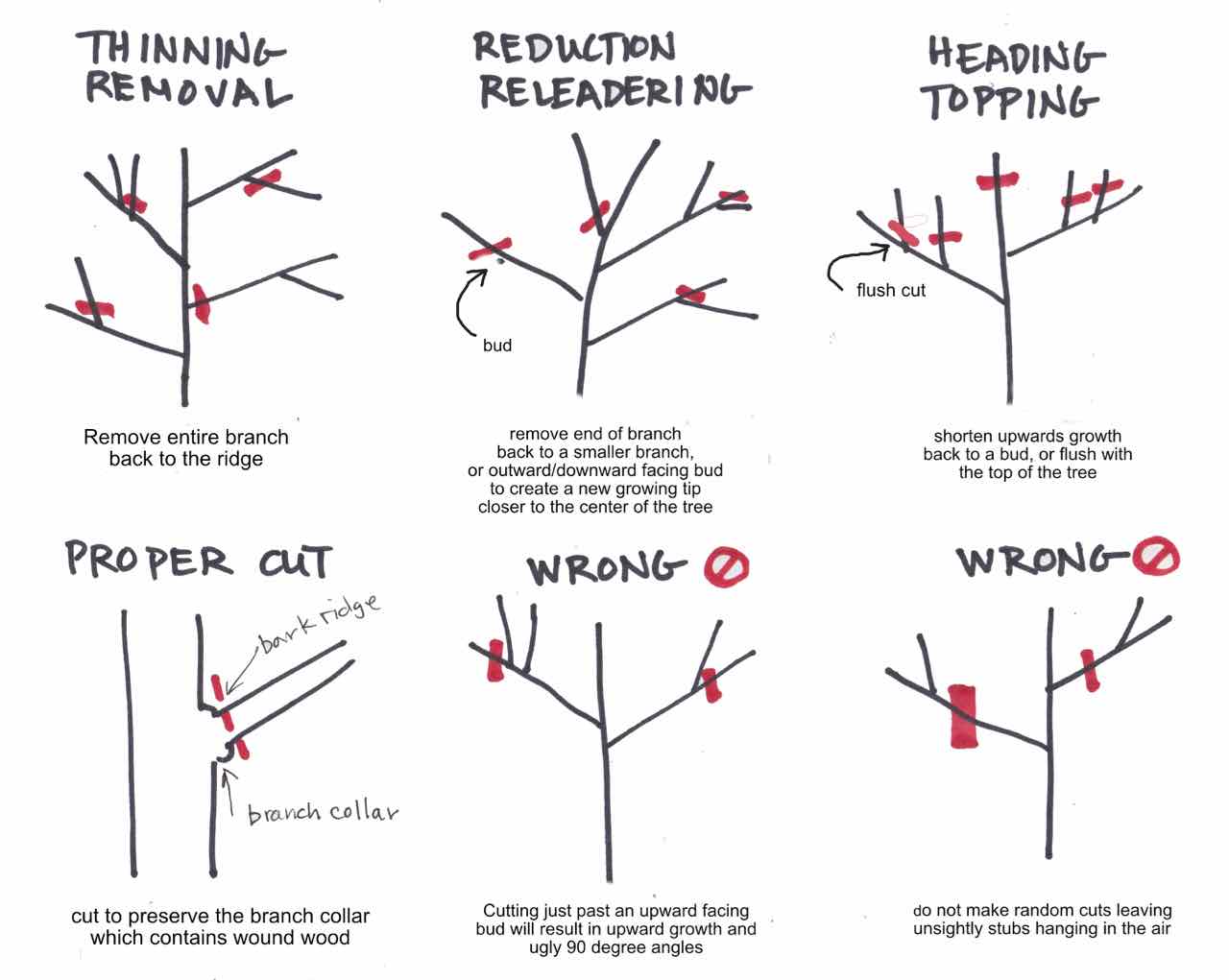2022
AUGUST
Hello Mailing List!
Just finishing this August newsletter up a little late here. July was a doozy…heat wave, irrigation difficulties, vandalism, transmission failure and the start of fire season. Small scale farming is a loosing proposition financially, so you’ve gotta love it for other reasons…
August in The Garden: Looking Towards Fall
Have your tomatoes started to ripen there yet? Mine in Southern Oregon started coming on around the first of August. If yours are not ready yet, they should turn soon and feed you through October. Early August is the time to start thinking about your Fall garden. Spring crops that have finished their cycle can be pulled and Fall crops put in their place. Think about lettuce, cole crops (broccoli, kale, collards, cauliflower), peas and root crops (radish, turnips, carrots, beets). Radicchio and chicory are great lesser known winter greens. Plants started in the month of August and even into early September will be ready to harvest in October and November and your root crops and hardy greens will grow through the winter. It is always tough getting things going this time of year as the soil is so dry and plants need good water to spread their roots and get established. Hand water your seed beds twice a day to keep seeds moist. Soak starts and beds thoroughly before planting. Drip irrigation is key and consider pulse watering. This is the process of watering in short bursts multiple times a day. If there is even a small amount of moisture in the soil, it takes up moisture more easily so the theory is to save water by never letting anything dry out. Three to five minutes 2-3 times a day—15 minutes a day equals less than 2 hours per week and your plants will look better, feel happier and be more productive. Cheers!
News From the North
Water is Life. My water right to the Rogue River, which I share with 6 other properties, depends on a WWII era pump…this behemoth tirelessly pumps 20,000 gallons of water an hour up to the top of the hill, where it then meanders in a dirt ditch through the forest to my field, taking about 2 hours and loosing 3-4000 gallons on the way. The pump needs to be primed with a hand pump each time to start and this year it would not prime anymore no matter how much we pumped…repairs delayed water 10 days and then I had to wait my turn…but before I got it, some idiots pried open the electrical boxes for the pump, which sits at the end of our road near a public boat ramp. They cut live wires running 800 volts and pull every scrap of copper wire they could. We were surprised we didn’t find a body…… $6000 and another 10 days later we got water again, but by this time my fields were bone dry and had ceased to grow…so on top of my portion of the repair bill I am now also feeding hay at a cost of $35 a day ($350 for 10 days—$1000 a month) until the pastures regenerate. Thanks goodness I did get one irrigation cycle in before temperatures hit 110 degrees. Then, on my way to pick up my bulk grain order in Roseburg, the transmission on my truck failed…I waited 3 hours for a tow in triple digit temperatures…and have yet to get the prognosis and estimate for repair, as my mechanic is booked nearly a month out. I’m not complaining…life is life…it’s just been a bit of a wild and expensive ride.
On more positive note…I continued work on my composting toilet outhouse. Heat has slowed me down a bunch, but it is framed with a roof and ready for sheathing. I brought in lots of wood chips and made things look pretty. Cleared out my crazy wildflower patch and topped it up with manure. Got two more sections of sheep shelter mucking done and laid down stall matts to make cleaning easier next time, Cleaned and tidied the rabbit barn. Cleaned and tidied and purged piles of building materials. Mowed and weed whacked everywhere to prep for fire season. And…get this—I rested a lot and tended my health. Whoa. The month of July I did the Whole30 cleanse, trying to battle some of the inflammation and pain I’ve been having. It was not too challenging (except for not having dairy in my morning coffee) and it did help. Then with most days in the high 90s and 100s I am up at 5, outside by 6 and done by 9 or 10 so daytimes are time to stay cool and rest. Think of that.
December Open House and Beef!
The dates for my Winter open house are earlier than usual this year December 3 & 4. Mark Your calendar, details to follow! After 2 years wait I will also finally be offering shares of delicious Wild Dexter Beef and will be transporting the shares to the Bay Area that weekend. I will officially announce availability and take deposits in November.
The Pictures
Lillies Coming on Strong! Dahlias struggling with a cucumber beetle infestation. Electric Box Vandalism
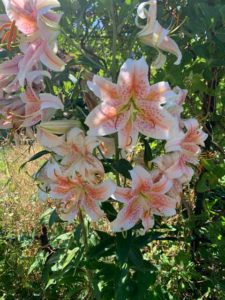
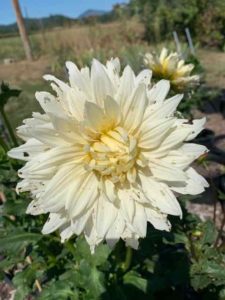

Late season fancy Iris. My pond full after finally getting water. Rabbit barn clean and freshened up with new chips (a broody chicken in the cage at the back)



Jim Montgomery with a pile of puppies. Me with Liza (puppy name), the terrier pup who will come home with me at the end of the summer. Fluffy, the Beast




JULY
Hello People!
Wow, what a month. I am flabbergasted. I sent my small tithing to planned parenthood this month and am looking into creating a network of locals who can offer “camping spots” for women coming from out of state. I argued with friends on facebook who were celebrating states regaining sovereignty (at what cost!!??). I want no city, county, state or federal government to have a say over my bodily sovereignty. A majority vote at any level should not trump my privacy. I am sure some will disagree or will point to complexities I am not addressing here– I am OK with that. But I will get off my soapbox now and go on to homesteading!
News From the North
Crazy weather. After tons of rain that was not anticipated, we got a mini heat wave in triple digits. The big irrigation pump went in the river and I fired it up and flooded my fields. The lambs are giant and I am looking at my first butcher date after the holiday. I got a couple big areas mucked out, significantly my main sheep shelter and then busted a move putting in a new floor and roof, the sheep should have a cleaner drier place to be next winter. I started on my composting toilet project, building a small boardwalk which the outhouse will sit on and looking forward to getting started on the outhouse this month. I got two deliveries of hay and filled my new hay barn with 200 big bales—about 11 tons of hay. I think I got a good deal at about $22 a bale. Quality hay is going for $30 at the feed stores, but on the other side, late harvests and rain has dumped a lot of crappy $5 bales on the market, not sure if that will end up being good or bad for the price of better hay. Sheep are picky eaters though and I am happy with the quality of hay I got from a local old timer. I harvested garlic and peas and I am still working on getting the garden in. The peppers and tomatoes are growing fine, but cukes, squash and melons have been slow to get going. June was fantastic for roses, with an ongoing abundant show. The dahlias are also looking good and starting to put out first buds and flowers. I finally finished my shearing season July 1, having had to reschedule some jobs several times due to rain and am now enjoying catching up on the farm and taking long naps in the heat of the day.




Top: Sheep Shelter Upgrade ~ 11 tons of hay!
Bottom: I had a great rabbit breeding season ~ Boardwalk for composting toilet outhouse
Garden Tip: Making Space
By July a lot of the Spring flowers have finished their life cycle and it is time to pull out and cut back to tidy up and make room for later blooming annuals and perennials. Daffodils can get topped to tidy them or the tops pulled if they have already dried up. Irises should have the flower stalks cut and dead leaves pulled off. Spent oriental poppies can be pulled (save the seed heads—some have windows that open at the top so the seed can be poured out, smaller head must be crushed to get the seed). California poppies can be cut back—they will grow again without being so leggy. Roses can be “deadheaded” to induce further blooming. Cut the hip off just above an outward facing leaf. If your garden has copious columbine, foxglove, nigella, calendula or other reseeding plants, cut the seed heads to reduce the amount of reseeding if they tend to overwhelm the garden. Winter greens that have bolted (gone to flower) can also be pulled and fed to chickens or to the compost pile. Plant winter squash, beets, carrots, beans, basil or lettuce in their place.
Farm Stays and Air BnB
If you are traveling North and want to stop in Southern Oregon, there are still dates available in my airBnB studio, RubyFox Retreat, right on the Applegate River. See listing and checking availability
I am also hosting by private arrangement in my guest room or glamping spot. Sliding Scale donation $75-150 or 3-4 hours of farm work per night. Email for photos and details. I also give tours of the farm for passers-through for a sliding scale donation.
The Future
I still haven’t figured out my next move. I am grateful to all those who continued to take classes over the past 5 years as I have come and gone from the Bay Area, but I think that is done for now. Teaching via Zoom has not been financially viable for awhile, and I don’t enjoy it as much as teaching live, so that chapter is also winding to an end. I am interested in hosting small groups for educational farm weekends, but I am not quite there yet. If you are urban and considering a move to a rural situation and want to learn more about rural living I am open to organizing something privately for you. I am also still considering offering my RV spot to the right person with an RV or tiny home. This could be a seasonal or short term gig 1-4 months. If that is something you want to consider, please be in touch.
JUNE
Hello Good People!
I can’t believe it’s June already…such strange weather here. Happy for all the late rain and cool temperatures though. It’s usually blazing here by now, but I am just starting to hook up my hoses and run my irrigation. We continue to get some rain and as the temperatures crawl higher the gardens are in a riot of flowers. Never since I have been here has there been such an “all-at-once” blooming as irises, poppies, snapdragons, bachelor’s buttons, foxglove, peonies and roses go off simultaeneously. I have a few more weeks of shearing, then lamb harvest starting and soon afterwards breeding and the cycle goes on…wash rinse repeat. There has been some dark stuff going around in the news and I encourage you to look towards the garden and toward nature for your reason to have some small hope and inner resource to go on…..
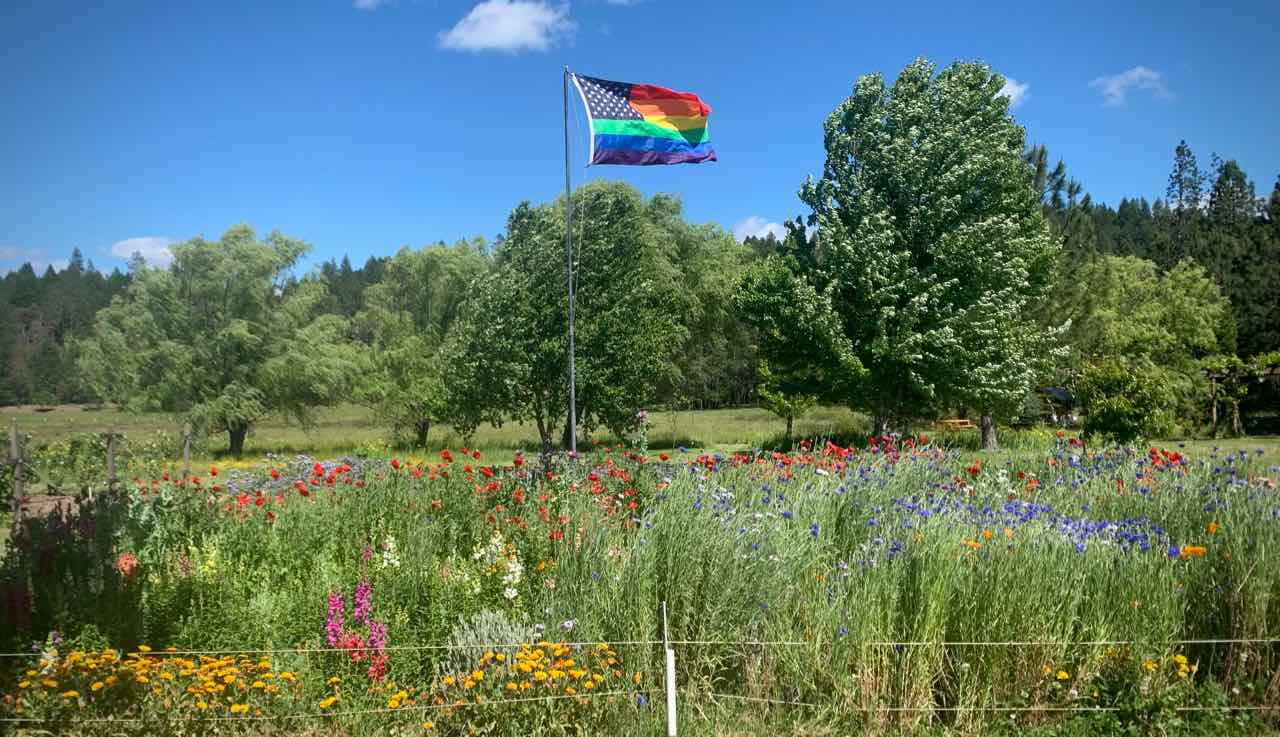 hope garden
hope garden
June in the Garden ~ Corn and more
It’s not too late to get your warm season crops in the ground. Tomatoes, cukes, basil, beans, squash all have time to thrive and produce with the long Bay Area growing season. While many consider corn a marginal crop for the cool coastal weather, I have successfully grown corn in Oakland using short season varieties like “Quickie” which takes only 60 days from seed to cob. Don’t both with corn in six packs—for good cob production your need a block of corn (16 plants minimum, though 24+ is better) and it is so easy to start from seed. Fold a washcloth or tea towel on a plate. Dump your corn seeds onto the opened towel and spread them into a single layer. Close the towel over the seeds and soak with water. Keep moist. After 2-3 days the roots will appear. When the roots are about 1/2 inch long plant them an inch deep. If your bed has drip irrigation plant one on either side of each emitter. Plant close, not more than 8-12 inches between rows. For a nice dense cob with plenty of kernels a grain of pollen must land on each silk. Each silk becomes one kernel. So the denser planting ensures good pollination. When the silks emerge you can agitate the corn, so the pollen distributes evenly.

 baby tractor with posthole digger ~ just one of the incredible irises
baby tractor with posthole digger ~ just one of the incredible irises
News From the North
The most exciting event of the last month was finally getting the post hole digger attachment on my baby tractor going! I dug my first holes and set my first fence posts, replacing three of the end posts in my rotational grazing system. The original posts were treated tree stakes cut in half, which had quickly rotted in my soggy clay and then had been propped up tied to T stakes with rope. I replaced this mess with solid 4 x 4 pressure treated posts properly set 2.5 feet deep with concrete. So satisfying to be able to do this on my own. My new hay barn was delivered (just a metal carport building, nevertheless, woo-hoo!) and my first load of hay is coming next week (stocking up early for next winter). I installed a new picnic table and shelves for my off-grid glamping area and I enjoyed a parade of fancy irises, many of which bloomed for the first time this year.
The Future
I am hoping to have some time this summer to clarify some kind of direction. I want to offer intensive training here on site, but the logistics of hosting a group with bathroom and meal needs is a bit overwhelming. I did get excited when I heard about “New Cowgirl Camp” and thought it would be awesome to offer something similar for women…though most of the skills would be more for rural application, building fences, rotational grazing, small scale livestock husbandry, water management and so on. Once my off-grid outdoor living space is complete I also have thought of just doing smaller scale farm weekends, possibly through air BnB or similar…..I am sure things will clarify. I will come to the bay area to deliver lamb a couple times summer & Fall and hope to offer a few classes in person classes timed with those trips. We shall see. The Winter Open House is on and slated for the first weekend in December. If you have wishes, thought or ideas for me, please share.

 curious lambs ~ hay barn
curious lambs ~ hay barn

 Before & After ~ Incredible Poppy
Before & After ~ Incredible Poppy
MAY
Happy (belated) May Day!
Beltane, May Poles, Spring Fertiltiy, International Wokers Day, Social and Economic Justice, Earth on the Rise. Yesterday on May 1st I spent the day in the garden tilling and planting. The dahlias all got planted and I am now on to prepping the veggies garden for onions and potatoes, tomatoes, pepper, basil and carrots. I’ll be seeding cukes and melons in flats and waiting for the winter squash to pop up where I direct seeded them.. The nights are still cool here, but I am hopeful for the coming bounty.
Farm to Consumer Heritage LAMB ~ Interested?
Hey Don’t worry, if you are already on my customer list for lamb I will be in touch to take reservations soon!
But I am curious who else on this list would be interested in purchasing excellent tasty heritage lamb for their freezer? I am partnering with another wonderful farm to bring a few more lambs direct to the consumer. These will be whole lambs in the 45-70 pound range (split with friends or family if you wish a smaller portion). You pay a deposit which covers butcher cost and a per pound rate for the meat at delivery/pick up…these prices still TBA, but it will be lower than you would pay for lamb at the grocery and far tastier. The lamb comes cut wrapped and frozen. You can read how farm to table works here. If you are interested to be notified when I am taking deposits just shoot me back an email.
Tom admiring Daphne’s haircut ~ Cleopatra posing
News From the North
Just back from ten days on the road. I enjoyed teaching gardening to a wonderful group of folks at Soil Sisters garden in Berkeley and sheared my way down the I-5 and up the 101, visiting many friends along the route. I have a break now for a few days to get my dahlias and vegetable garden in the ground and catch up on weeding and mowing before diving into another month of shearing here locally. A new girl calf emerged into the world yesterday, super cute how the small herd of cattle gathers round her and protects her. The baby cows sleep alot in their first few weeks. My metal building for hay storage is arriving in a few weeks, as well as a post hole digger attachment for my tractor and a picnic table for my glamping area. I am looking forward to getting building on a few things…a composting toilet at long last and a solar shower…..I have enjoyed a bunch of late rain but we also got snow (!!) and a hard frost which destroyed the fruit set on all the stone fruit (no peaches or nectarines for me this year!) as well as the budding leaves on a number of tender things so everything seems late this year…but peonies, iris, columbine, roses and foxglove are all about to burst into bloom whenever we get a warm day….


Peonies Getting ready to Go! ~ Hops Too!
APRIL
Happy April Fools Day! I am not a very good prankster…so no jokes from me this morning….but here’s a nice article from he History channel on the potential origins of April Fool’s Day https://www.history.com/topics/holidays/april-fools-day. My suspicion is that is has something to do with seasonal shifts and tricks of nature. After few really hot days here, we got frost this morning…but Spring marches on…
April in the Garden
Although you are seeing tomatoes and basil in the nurseries, the nights are still a bit cool for warm season crops and in my experience you don’t get tomatoes any sooner if you plant now or a month from now, except for cherry tomatoes which seem to thrive like a weed wherever they are. Warm season crops won’t die with 45 degree nights, but they don’t like it much either. So you can continue to plant cool season crops outside early April (chard, leek, green onion, lettuce, other salad greens). Warm season crops can be started indoors or on heat mats (cucumbers, squash, pumpkins, eggplant, peppers, tomatoes, basil melons) and planted in the ground towards the end of the month or early in May. For more info on what to do when, here’s a nice guide from the Alameda County Master Gardeners. It’s also great time to tend your indoor plants and succulents, potting up, dividing and freshening up the soil.
News From the North
I wrapped up all my pruning work early in the month and have been puttering and taking care of many small tasks and things that have been on my list awhile….Lambs continued to trickle in and 4 litters of bunnies were born. Neutering for kittens, picked up a sheep that was fostered at another farm along with 3 gorgeous replacement ewes, visited some Llamas to see if one would come home with me to replace Natasha (RIP), took a whirlwind weekend trip to Portland where I saw lots of friends and bought too many plants, picked up a tote of grain in Roseburg and a load of hay in the Applegate Valley. Fixed my shop door and stretched a line of fencing that was broken, upgraded fence latches, got my taxes done, put up a tower for the hops, took down part of the failing grape arbor, started some seeds and built a raised bed for my ailing blueberries….sounds a little like life eh? The daffodils,tulips and magnolia are blooming, Lilies and peonies popping their heads up and lilacs and columbine are about to go crazy. The fruit trees are in full pollination action. I am looking forward to shearing season, meeting some of you in person at my April Gardening class and getting my summer garden going.


MARCH
Hello Dear Subscribers!
Wow. February really is the shortest month…it went by in the blink of an eye…the days are getting longer and we are finally getting some rain up here after a very dry January and February. The first daffodils are showing their sunny faces and the stonefruit is threatening to flower. I know Spring has already pretty much sprung in the Bay Area, but I am hoping for more rain for all of us up and down the coast.
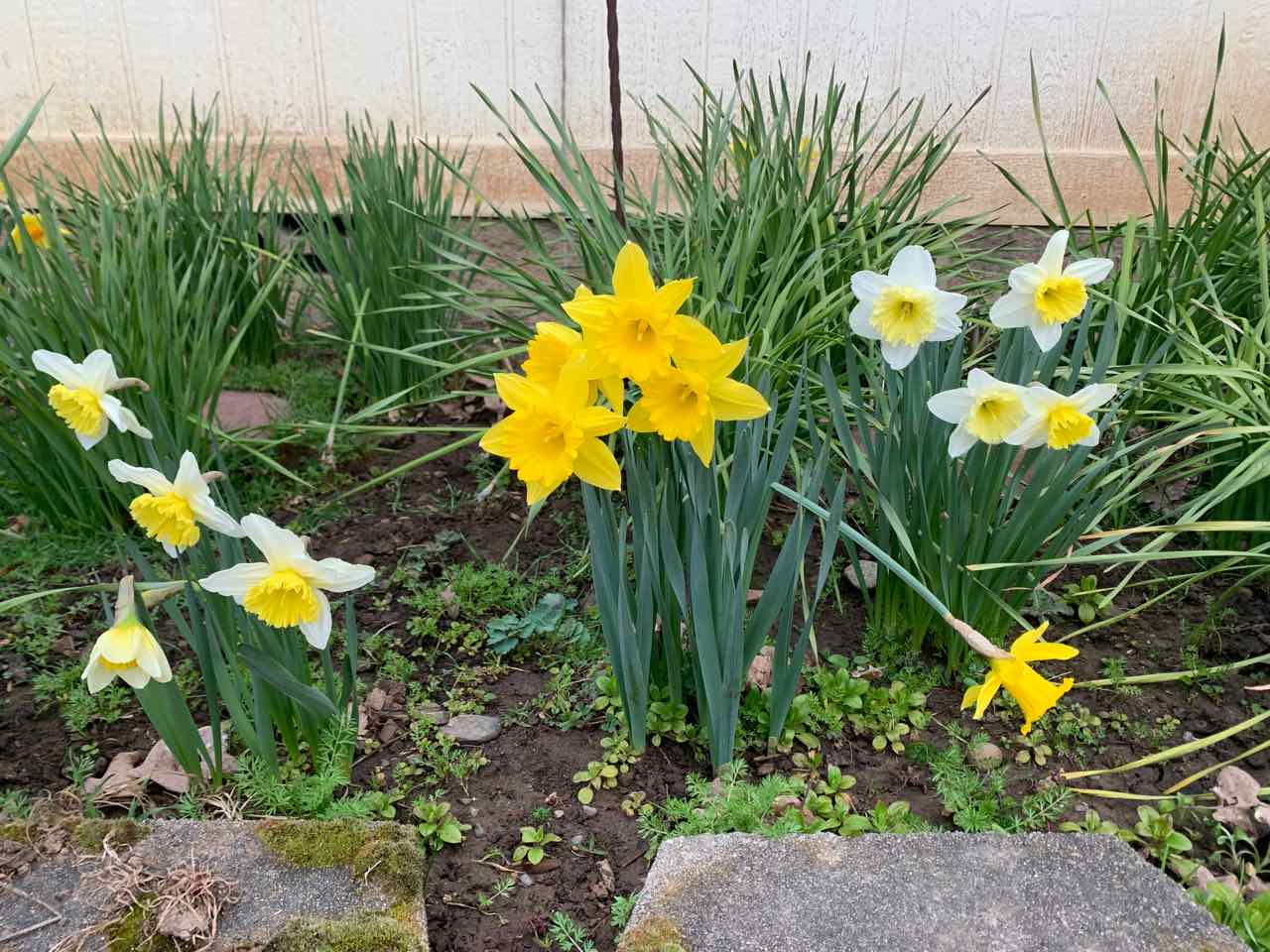
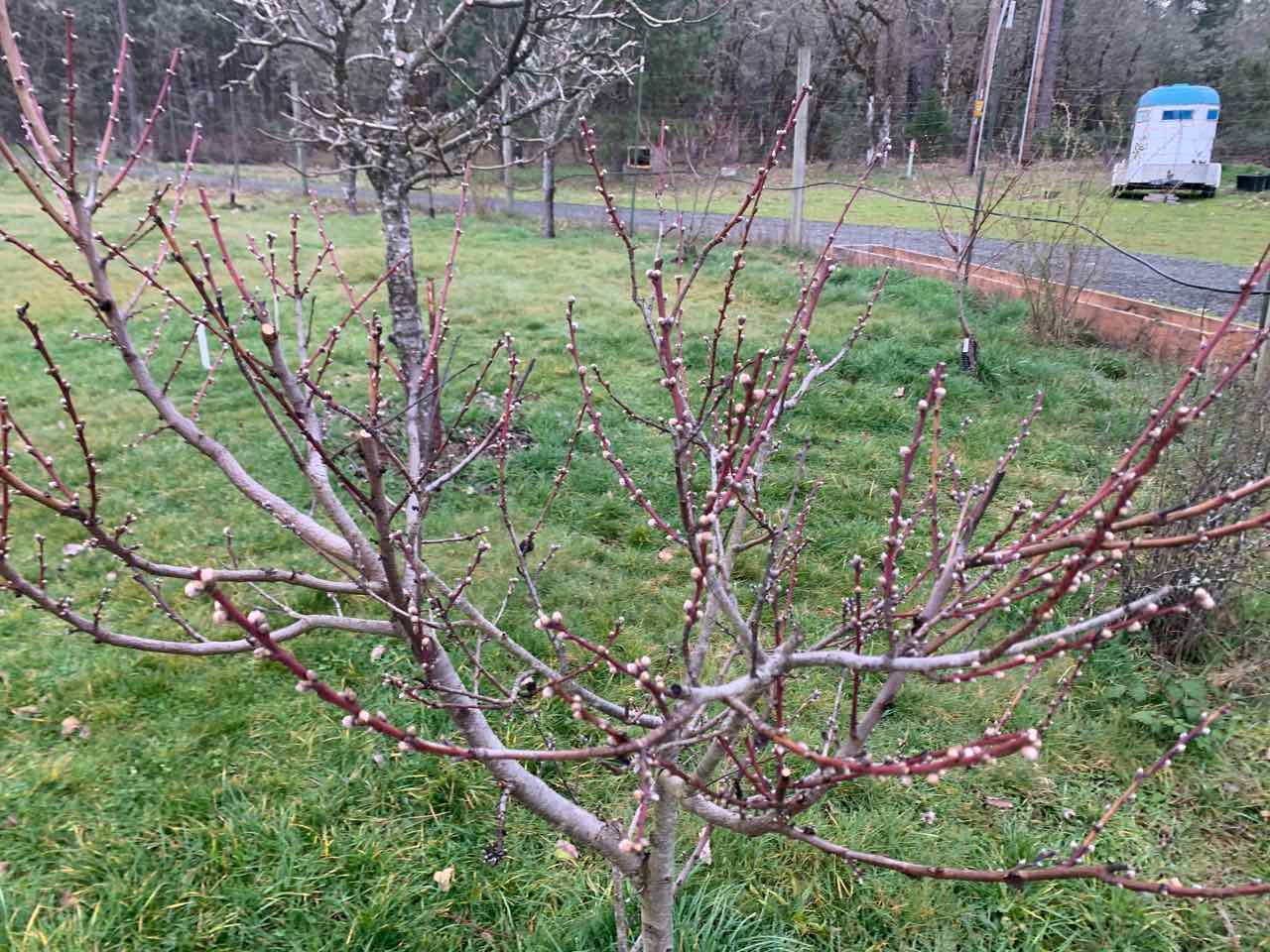
sunny Spring faces ~ Peach tree close to blooming
March in The Garden
With days getting longer, it is time to start thinking of tending the soil, getting some cool season crops into the ground and doing maintenance on drip irrigation systems. Soil in raised planter beds and native soils alike should be turned and amended. Adding ample compost each year offers plants a smorgasborg of nutrients and increases numbers of soil micro-organisms vital to healthy plants. Most cool season crops are easily started from seed, but there will also be beautiful starts available in local nursuries by this time. Lettuce, kale, chard, beets, peas, collards, radishes, broccoli and cauliflower can all go in the ground now. Drip irrigation systems should be opened on the tail end and flushed out. Then re-cap and run to see that everything is functioning, tweak and replace the bits that are not. In drought times I reccommend pulse watering. This a short but frequent watering schedule such as 5 minutes 2 x per day. This gives a steady flow to the plants and keeps soil moist but not waterlogged. Moist soil actually takes up water better than bone dry soil, which becomes hydrophobic.
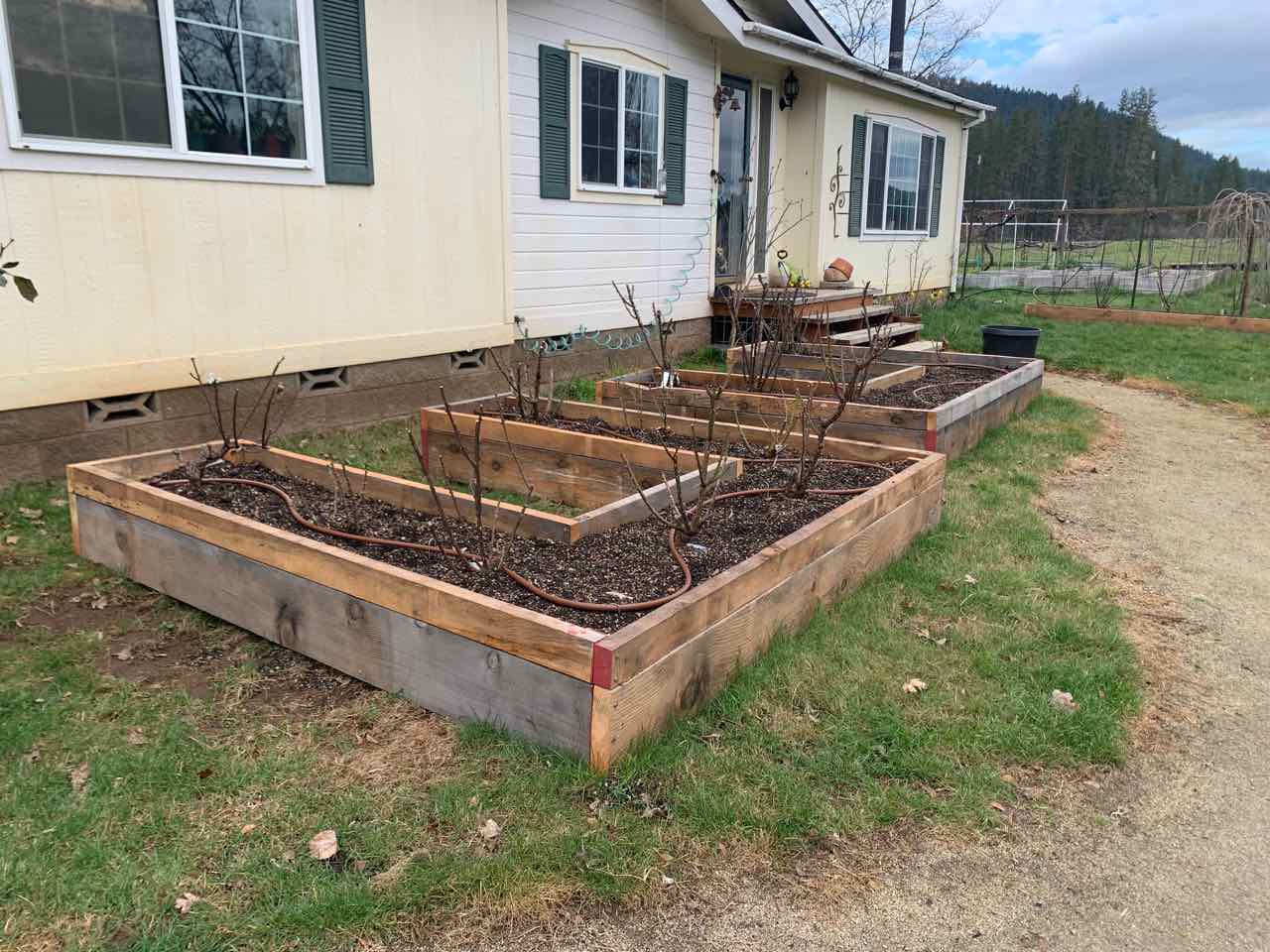
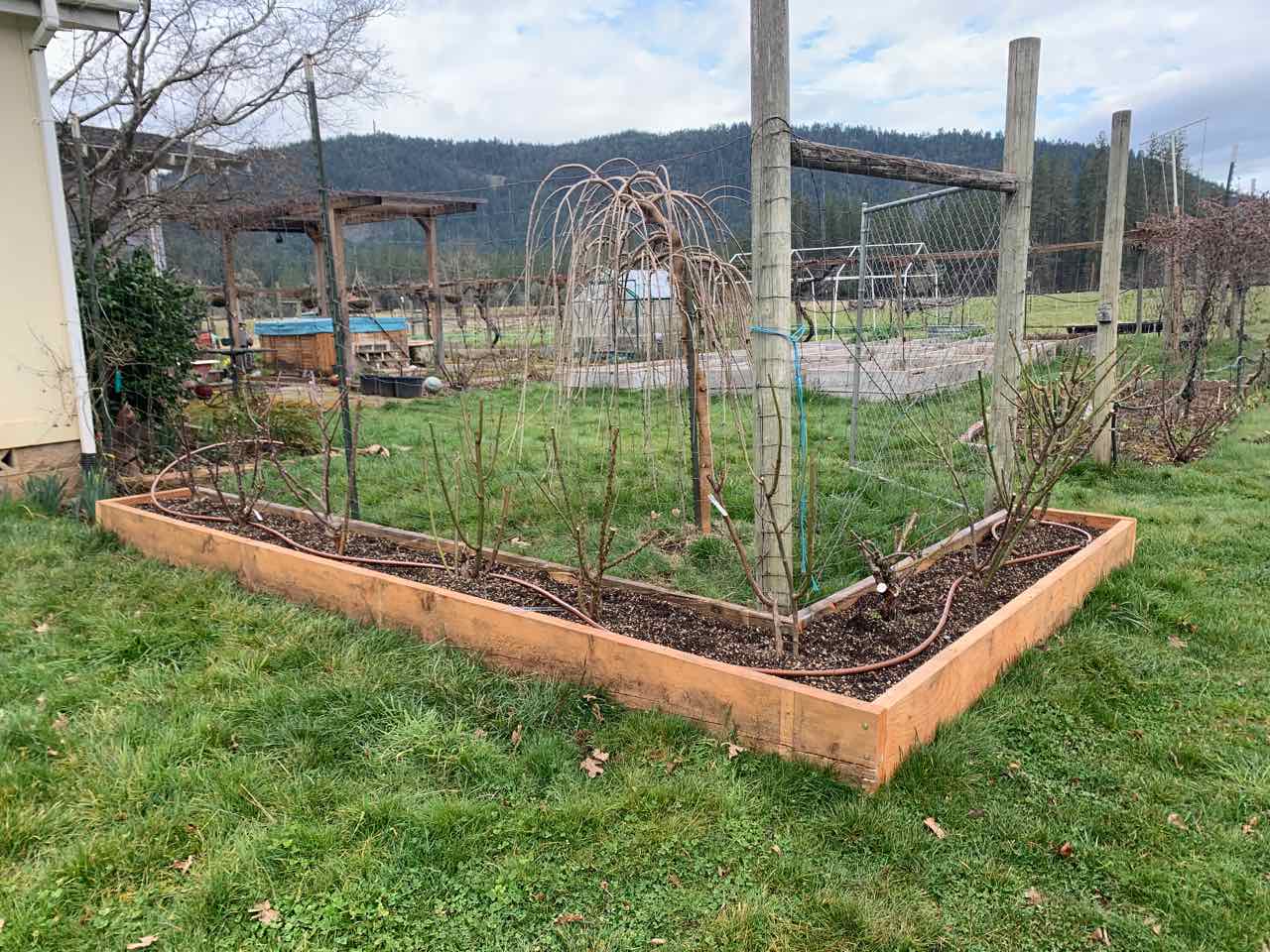 new beds for roses
new beds for roses
News From the North
A big break in lambing…only 2 lambs arrived this past month, I am waiting on 10 more sheep to lamb. They’ll probably come all at once early this month. Baby rabbits are also on the way, I am expecting them early next week. In February I pruned fruit trees like crazy. I learned a lot and worked on some truly awful trees and tried to make a difference. Just a few more jobs remain and I will be happy to have a little time off soon to focus on projects here on the farm. I did manage to finish weeding and clearing garden beds in February. I also sorted all the roses that have been living in pots since I got here, rehomed many, built new planter beds, pruned and transplanted the ones I am keeping into the new beds. I pruned the rest of the roses, even though it’s a bit early for my region and also pruned all the grapes. I held a grafting class at the farm which was a success. We had lots of freezing nights here and even got down into the middle teens which is rare for the area. Other than that, stupid stuff like going to the doctor and getting an alignment for my truck. There ya go! Life.
FEBRUARY
Hello Beautiful People!
I sit to write on a foggy river morning…the storms were promising but it has not rained here in weeks and I am starting to wish for a good soaking. Lots going on here—the good kind of busyness as we move towards Spring…
For Every Season Turn Turn Turn: Changes at the Institute of Urban Homesteading
Last year I lost my non-profit status due to my own bureaucratic negligence. I tried to get it back but the amount of paperwork and financial backtracking was too great. 2021 Revenues for IUH came in at an all time low. An organization which once generated about 75K a year logged only 2K in 2021. My ability to sell classes in the Bay Area has quite obviously diminished and it is time for me to bring my activities more into focus in Oregon….The classes planned for Spring 2022 will stay on the books. I encourage you to attend!! And it will be an especially rare treat to offer a gardening class in person in April, so I do hope a few more of you sign on for that. The Bay Area will always be my home and I intend to continue to offer classes and services there as I can, though it will be on a much less regular basis. I will continue to sell lamb and beef to Bay Area customers and continue to offer farm goodies at my annual Winter Open House. The open house is an important part of my year–I appreciate your support and patronage of my small farm! I haven’t decided if I will continue to write a monthly newsletter after June 1 or if I will go to a quarterly format..I will keep you posted! And I do hope a few of you will join me summer or fall for glamping & work exchange. I am not quite sure about hosting a full-on Farm Summer Camp this year, but am considering offering an educational camp-out weekend in August or September to test the waters. We’ll see.
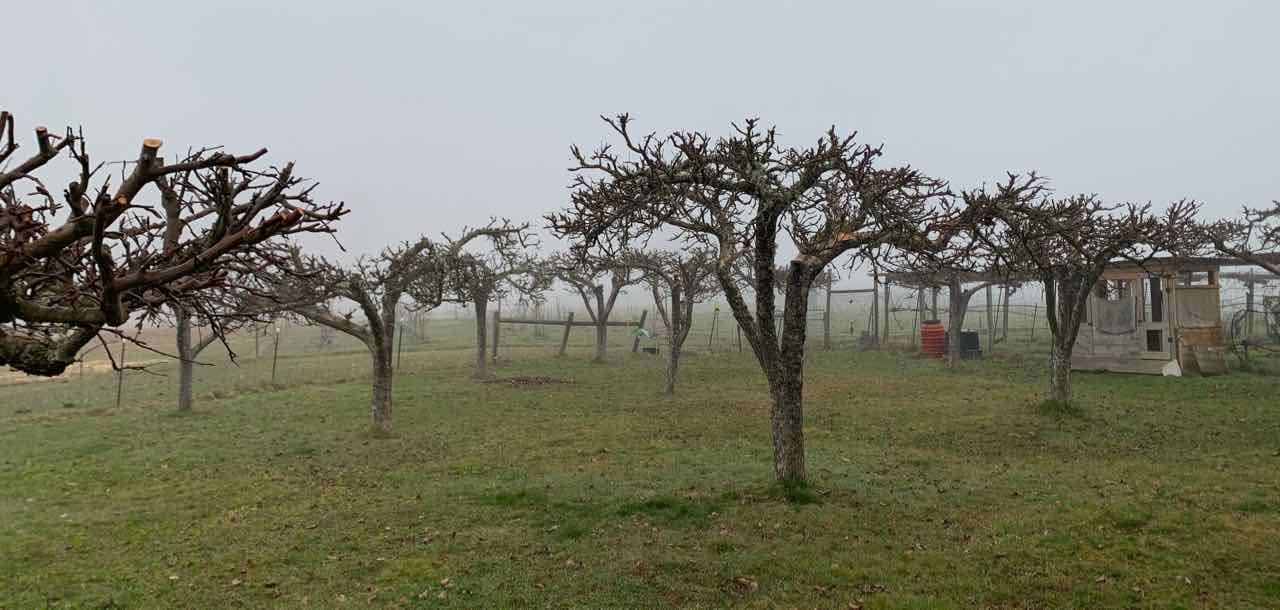 a well pruned apple orchard
a well pruned apple orchard
February in the Garden: Tending your Fruit Trees
Fruit trees (except citrus) are generally pruned when they are dormant for Winter rest. February is almost too late in the Bay Area with our weird shifting weather, so it’s time to get on it! In my experience most people are either too kind to their trees and don’t prune aggressively enough or prune too hard in the wrong places and end up with ugly trees. Prune to maintain size for ease of management and to increase or control fruit production. The ideal shape for the backyard orchard is an open center with 3 to 4 main scaffolds maximum (the largest branches). Maintain size at a height that you can reach from the ground, or no taller than you can pick and prune on a 6 foot ladder. Start by removing anything that is in the center of the tree, including any large upright trunks and sprouts on the main trunk. Then remove any suckers growing from the base and water sprouts growing straight up at the top of the tree. Top the tree at the height you like, then remove the 5 Ds: anything dead, dying, diseased deformed or doubled (2 branches growing parallel in the same space). Finally remove any new growth back to 2-4 buds. Yes—you can remove up to 30% of the established wood in any one year, but also up to 90% of the new growth that grew the previous season. As a general rule, make an angled cut just past a downward or outward facing bud…this will encourage outward gently sloping growth (see the proper cuts guide at the end of this newsletter). Peaches, figs and nectarines produce their fruit on 1 year old wood, for only one year. Plums produce fruit on wood that is at least 2 years old, for up to 8 years. Apples, pears and cherries take 3 years to develop fruit wood, but then produce on the same spurs 5-15 years. You neither want your tree to get too leggy, nor do you want to cut away all the fruit and you want your fruit on branches large enough to support the fruit without breaking. All this said, you have to work with what the tree gives you, so older overgrown trees may never get to an ideal shape. Do your best and observe how to tree responds!
The BAHH List
Some of you may already know about this well-kept secret. BAHH stands for Bay Area Homestead Hook-up. This is a list-serve I have maintained for many years…a place where homesteaders and wannabes can share information and resources. I capped the list at 450 to keep it somewhat intimate, and for a long time there was a waiting list, but there is currently room for new subscribers. Consider joining if you like to engage with liked minded folks via email. The list is currently fairly low volume…maybe 2-10 emails per week and it’s great fun. If you would like to join, send an email from the address you would like to subscribe to: bahh-subscribe@lists.riseup.net Once you have joined you can send to the whole list by addressing your email to bahh@lists.riseup.net
 waiting for breakfast on a foggy morning
waiting for breakfast on a foggy morning
News From the North: Living the Dream @ Faerie Road Farm
January was a beautiful month with hard freezing nights and sunny afternoons in the low 50s. I offered a series of free fruit tree pruning classes on the farm and they were a great success! A couple dozen folks were introduced to the art of fruit tree pruning and got hands-on experience on my trees, plus I actually made some money from donations and jam sales. Win win! The real boon was that posting these classes gave a giant boost to my fruit pruning business. I gained over 20 new customers, so as well as pruning my entire orchard last month I also was out in the community 2-3 days a week pruning for others and making new friends. January saw the birth of more early lambs. There are now fourteen of them bouncing around the pasture. The rest of my flock is heavy and I expect another big round of lambs early March. The days are getting longer and I am thinking about breeding rabbits soon as well. I received a visit from my ex-partner who helped with crutching & tagging the expecting ewes—this is specialty shearing of bellies, udders and butts which helps me see the udders to assess due dates, keeps things clean down there and helps the newborn lambs find the teats. In January I also tended to my berry patch, pruning and stringing up the vines for the new season and moving an entire row of berries, since I made the newbie mistake of putting my rows too close together. Now the rows are 12 feet apart, plenty of room to mow between them if needed and to pick berries without bushwhacking through a jungle of brambles. Last year I sold extra produce through Daily Blessings Farm, a local customizable CSA. For 2022, the head farmer there has formalized the process by forming the Josephine County Farm Collective. It is a great way to move some of my extra fruit & value added goodes, connect with other growers and make a small paycheck without having to deal with the work of setting up a farmers market stand (not viable for me for a whole host of reasons). We had our first meeting in January and it’s an exciting opportunity. Finally, two gorgeous kittens came to live at the farm in January…bringing the farm total to 6 (I think that is the crazy cat lady threshold).
 Hunter & Romeo, new kids on the block
Hunter & Romeo, new kids on the block
Spring Classes
Consider signing up at least a week in advance of the class. This lets me know there’s enough interest for them to take place!! Calendar HERE
Announcing HEAL: Hillside Earth-Arts Lab
I have been working with friend and colleague James Ryder to help him jump start a new educational project and sustainable resource hub in El Cerrito.
HEAL (Hillside Earth-Arts Lab) is launching this Spring with some free courses! I hope you will join James, check out his teaching and throw a few donation dollars his way for the project.
 March 6th, Sunday 11am-1pm
March 6th, Sunday 11am-1pm
The Vernal Garden: Leafy Greens and Root Crops
In this gardening class focused on vigorous, cool season annuals, we will learn the art of small-space planting, the integration of root crops, best uses for mulch and lots more!
FREE event/NOTA/donations welcomed
El Cerrito location given on registration
Registration/Information: JamesRyderYoga@gmail.com
March 20th, Sunday 11am-1pm
Rain Harvesting: Tanks, Barrels and Buckets, Oh My!
Learn to gather one of our greatest free resources, RAIN! Check out two functional 530-gal steel rain catchment tanks and learn about the tools, materials and resources needed to set up your own home system!
FREE event/NOTA/donations welcomed
El Cerrito location given on registration
Registration/Information: JamesRyderYoga@gmail.com
JANUARY
Happy 2022
I hope everyone had a wonderful New Years weekend and is launching forth into 2022 with gusto on this first business day of the year. We had a break in the storm here this past weekend, which was a relief. I love that we are getting rain/snow, but farming in clement weather is not very fun. I spent New Years Day mucking out the pigeon coop and the bunny barn and working on a cover for my grain bin since I am tired of rat poop in my grain and can’t seem to trap them all. Sunday I had some friends over for a Tamalada (tamale making and eating party), over 100 tamales made and packing our freezers….now onward to 2022!
Thank You Everyone!
Thank you to everyone who came out to my Winter Open House! It was a sweet event. I missed being able to offer tastings but it was great to see friends and supporters and the happy faces of folks up stashing up on goodies. Thank you as well to my gracious hosts, the Ravenel family, for allowing me to take over their home for three days. Surprisingly, it was a bit quieter than last year, so I still have goodies available for your pleasure. Read on for information on how to get those!


Goodie Boxes for the New Year
An updated list of what is available is online HERE. Pick and choose what you want (email me your list, shipping is flat rate $10) or purchase a goodie box. Goodie boxes come in 4 sizes, you get the value of what you pay for the box in goodes, I pay the shipping. The boxes can include mustard, jam, shrubs, salves, cordials, vinegar, salsa, dried fruit, tiles and more. Small, Medium, Large, XL $50/$75/$100/$125


News From the North
December was quite a month. While I was traveling for the open house the storms began. We got a lot of snow. Snow is beautiful but challenging for farming. My main sheep shelter has a roof made of PVC and will collapse if the snow is not knocked off regularly, so I had a number of anxious nights where I had to set an alarm and roust myself into the freezing night to check. This shelter also flooded which added to the anxiety, knowing my sheep had no dry place to be. My hay is currently stored under tarps and getting to it when the tarps are covered with 6 inches of snow while it is snowing is also not what people dream about when they think of farming. The issue came to a head shortly after christmas when I awoke to find the first lamb of the year unresponsive in the snow. The mama had access to dry warm space, but didn’t use it. Sort of an “anxieties-confirmed” moment. There was a break in the weather that day so I sprung into action…created a couple more lambing pens and confined all expecting mamas to dry spaces with heat lamps. Put down an improvised floor of palettes and plywood in my shelter to get the sheep out of the flood. I had a set of healthy twins later that night, and 3 more sets of twins have arrived since. Clearly I will put a solid roof and floor on my shelter before next winter. I can’t imagine why I did not do it before, except that the last 3 winters have been so mild.
